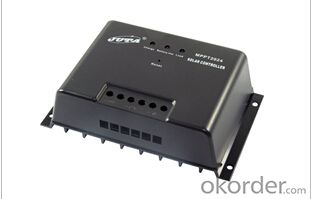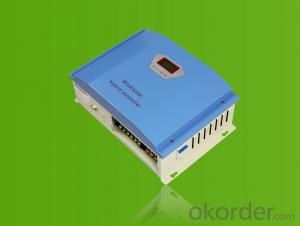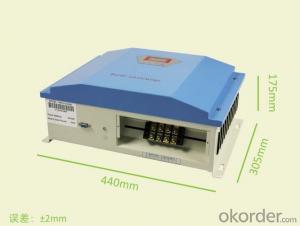Midnite Solar Controllers Maximum Power Tracking Solar Controller Model MPPT 20
- Loading Port:
- Shanghai
- Payment Terms:
- TT OR LC
- Min Order Qty:
- 5 unit
- Supply Capability:
- 150 unit/month
OKorder Service Pledge
OKorder Financial Service
You Might Also Like
1. Structure of MPPT Maximum Power Tracking Solar Controller Model MPPT 15/ MPPT 30
The controller is an indispensable part of solar system, this MPPT Maximum power tracking solar controller is remarkable, because it can adjust with intelligence the working voltage of solar panels, so that the solar panels can reach the maximum power spot of the V-A characteristics curve during the work. Compared with the common solar controller, this MPPt Maximum power tracking solar controller can increase the use ratio of the solar panels power by 10-30%.
2. Main Features of MPPT Maximum Power Tracking Solar Controller Model MPPT 20
· Protection against overcharging of the accumulator
· Protection against over discharging of the accumulator
· Protection against reverse discharging of the accumulator to solar panels
· Overload protection and short circuit protection
3. MPPT Maximum Power Tracking Solar Controller Model MPPT 20 Images

4. MPPT Maximum Power Tracking Solar Controller Model MPPT 20 Specification
Type | MPPT20-12/25 | MPPT20-24/50 |
Nominal Voltage | DC:12V | DC:24V |
Voltage scope available for Max. solar power tracking | 12-25V | 24-50V |
Max. open circuit voltage for solar energy | 25V | 50V |
Max. charging current | 20A(referring charging current from accumulator) | |
Max. discharging current | 20A | 20A |
No load losses | ≤8mA | ≤40mA |
Off voltage after full charging | 14V | 28V |
Off voltage when undervoltage | 10.5V | 21V |
Starting recovery voltage | 12.6V | 25.2V |
Efficiency | 95%~97% | |
5. FAQ
We have organized several common questions for our clients, which may help you sincerely:
a) How about your capacity?
We can produce 300,000 set inverter per year currently, 60,000 set solar energy charge controllers. And the product is sold towards domestic and Europe, Australia and Africa etc.
b) How to guarantee the quality of the products?
The company presses the ISO9000 quality management system control product quantity strictly, the export production all passes the relevant national company check (CE, ROHS), and get high evaluation of the customer.
c) How long can we receive the product after signing Sales Confirmation?
Generally speaking, if there is enough quantity of finished products which can meet the clients’ requirement, we can manage the delivery within three to five working days according to the instruction of the payment terms in the Sales Confirmation; if the products need some time to get ready, we will arrange the delivery as soon as possible after the manufacture.
- Q: Can a solar controller be used in a solar-powered irrigation system?
- Yes, a solar controller can be used in a solar-powered irrigation system. A solar controller is responsible for managing and regulating the charging and discharging of batteries in a solar power system. In a solar-powered irrigation system, the solar controller can be used to control the flow of electricity from the solar panels to power the irrigation pumps, ensuring efficient and effective water distribution.
- Q: How do I choose the right solar controller for my system?
- When choosing the right solar controller for your system, there are a few key factors to consider. Firstly, you need to determine the maximum current and voltage requirements of your solar panels. This will help you select a controller that can handle the input power of your system. Additionally, consider the type of battery you have and ensure that the controller is compatible with its charging requirements. It's also important to think about the specific features you need, such as temperature compensation or remote monitoring capabilities. Lastly, consider your budget and choose a controller that offers a good balance between affordability and quality.
- Q: Can a solar controller be used with different types of batteries (e.g., lead-acid, lithium-ion)?
- Yes, a solar controller can be used with different types of batteries including lead-acid and lithium-ion. However, it is important to ensure that the solar controller is compatible with the specific type of battery being used in order to optimize charging and prevent damage to the battery.
- Q: Can a solar controller be used in a solar-powered submarine?
- Yes, a solar controller can be used in a solar-powered submarine. A solar controller helps regulate and optimize the charging of batteries from solar panels. In a solar-powered submarine, the solar controller can effectively manage the charging process and ensure the batteries receive the right amount of power from the solar panels, allowing for efficient and sustainable operation underwater.
- Q: Can a solar controller be used with sealed batteries?
- Yes, a solar controller can be used with sealed batteries.
- Q: Can a solar controller be used with a solar-powered vertical farm?
- Yes, a solar controller can be used with a solar-powered vertical farm. A solar controller regulates the flow of electricity from the solar panels to the farm's electrical system, ensuring that the batteries are charged efficiently and preventing overcharging or damage. It is an essential component for managing and maximizing the use of solar power in a vertical farm.
- Q: What is the maximum cable size that can be used between the solar panels and the load?
- The maximum cable size that can be used between the solar panels and the load depends on various factors such as the distance between the panels and the load, the amount of power being generated by the panels, and the electrical specifications of the load. It is best to consult the manufacturer's guidelines or seek advice from a qualified electrician or solar professional to determine the appropriate cable size for your specific system.
- Q: How does a solar controller prevent damage to batteries?
- A solar controller prevents damage to batteries by regulating the charging process and ensuring that the batteries receive the appropriate amount of voltage and current from the solar panels. It prevents overcharging by disconnecting the panels from the batteries once they are fully charged, and also prevents deep discharge by disconnecting the batteries from the load when their voltage drops to a critical level.
- Q: What is the maximum number of parameter settings supported by a solar controller?
- The maximum number of parameter settings supported by a solar controller may vary depending on the specific model and brand. However, in general, solar controllers can typically support a range of parameter settings, such as battery voltage, charging current, load control, and temperature compensation. The maximum number of parameter settings can vary from a few basic settings to more advanced models that offer a larger number of customizable options.
- Q: Can a solar controller be used with solar-powered water treatment plants?
- Yes, a solar controller can be used with solar-powered water treatment plants. A solar controller is responsible for regulating and optimizing the charging and discharging of batteries in a solar system. Since solar-powered water treatment plants rely on solar panels to generate electricity, a solar controller is essential to ensure efficient utilization of solar energy and to protect the batteries from overcharging or excessive discharge.
Send your message to us
Midnite Solar Controllers Maximum Power Tracking Solar Controller Model MPPT 20
- Loading Port:
- Shanghai
- Payment Terms:
- TT OR LC
- Min Order Qty:
- 5 unit
- Supply Capability:
- 150 unit/month
OKorder Service Pledge
OKorder Financial Service
Similar products
Hot products
Hot Searches
Related keywords

























